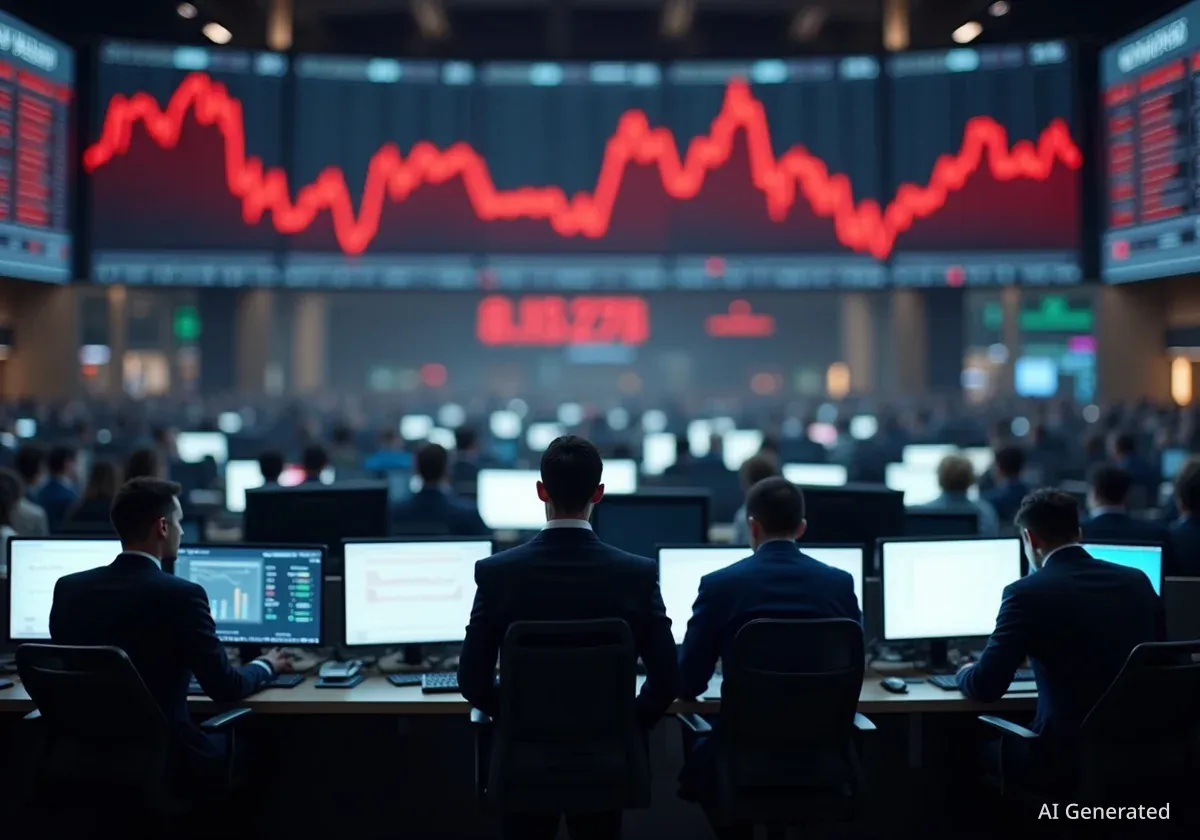Ethereum's price experienced a significant downturn, falling from nearly $4,300 to a low of $3,510 before a slight recovery. The sharp decline was part of a wider market sell-off triggered by renewed geopolitical tensions, which led to nearly $19 billion in liquidations across the cryptocurrency market.
The primary catalyst was an announcement by U.S. President Donald Trump regarding a potential 100% tariff on Chinese goods. This move prompted a flight from risk assets, impacting both digital currencies and traditional stock markets, while safe-haven assets like gold saw an increase in value.
Key Takeaways
- Ethereum's price dropped to a low of $3,510 after trading near $4,300, testing a critical support level.
- The sell-off was fueled by a U.S. announcement of a potential 100% tariff on Chinese imports, causing broad market uncertainty.
- Nearly $19 billion in crypto assets were liquidated in a single day, indicating widespread panic among traders.
- Technical indicators show that the $3,500 level is a crucial long-term support zone for Ethereum. A break below this could lead to further declines.
Geopolitical Tensions Trigger Widespread Sell-Off
The sudden downturn in financial markets was initiated late Friday following a social media post by President Donald Trump. He announced that the United States would impose a 100% tariff on all Chinese imports, with a proposed start date of November 1, 2025. The statement also suggested the date could be moved forward, adding to market instability.
This development immediately created a risk-off sentiment among investors globally. Traders moved capital away from assets perceived as high-risk, such as cryptocurrencies and equities, and into safer assets. The news intensified concerns about a potential trade war, impacting supply chains and global economic growth forecasts.
Why Trade Policy Impacts Crypto
Cryptocurrencies like Ethereum are considered risk assets by many institutional and retail investors. During times of macroeconomic or geopolitical uncertainty, investors often sell these assets to reduce their exposure to volatility. They typically move their funds into more stable, traditional safe havens like gold or government bonds. A major tariff announcement signals economic instability, which directly triggers this type of market behavior.
Further complicating the situation were rumors that President Trump might cancel a planned meeting with Chinese President Xi Jinping at the APEC summit in South Korea, scheduled for October 29-31. However, President Trump later addressed these rumors in a media appearance.
"But I don't know that we're going to have it, but I'm going to be there regardless, so I would assume we might have it," he stated, confirming the meeting had not been officially canceled.
Despite this clarification, the initial tariff announcement was the dominant factor driving market behavior. The uncertainty it created was enough to cause a significant ripple effect across all financial sectors.
Market Reaction Across Asset Classes
The response to the tariff news was swift and severe. Traditional stock markets saw significant losses as investors reacted to the potential economic fallout. The S&P 500 index fell by 2.71%, while the Dow Jones Industrial Average dropped by nearly 1.90%.
In contrast, assets traditionally seen as safe havens performed well. The price of gold, a classic hedge against economic uncertainty, surged by 1.02% to reach $4,016 per ounce. This movement highlights the broader shift in investor sentiment away from growth-oriented assets and toward capital preservation.
The cryptocurrency market experienced one of its largest single-day sell-offs in 2025, with total liquidations approaching $19 billion. This indicates that a large number of leveraged positions were forcibly closed, amplifying the downward price pressure.
The digital asset space was hit particularly hard. Bitcoin, Solana, and other major cryptocurrencies recorded double-digit percentage losses. Ethereum was not immune, and the pressure was also visible in institutional products. Blackrock's Ethereum ETF, known by the ticker "ETHA," recorded an outflow of $80.2 million, signaling that even large institutional players were reducing their exposure.
Ethereum Technical Analysis: A Decisive Moment
From a technical perspective, Ethereum's price chart now reflects a bearish short-term outlook. The recent price drop caused a bearish crossover between the 20-day and 50-day exponential moving averages (EMAs). This is often interpreted by traders as a signal of increasing selling pressure.
However, a more critical long-term indicator is providing some support. The 200-day EMA, which represents the average price over the last 200 days, has so far held firm. This level, combined with the horizontal support at $3,500, forms a crucial zone for Ethereum's price. Maintaining this support is vital to prevent a deeper correction.
Potential Future Price Scenarios
The market is now at a crossroads, with two primary scenarios depending on how the price reacts at this key level.
- Bullish Scenario: If the $3,500 support zone holds and buyers step in, a recovery could be possible. The first targets for a rebound would be the $3,900 and $4,100 resistance levels. A stabilization above these points could restore confidence in the market.
- Bearish Scenario: A decisive break below the $3,500 support and the 200-day EMA would be a significant bearish signal. Such a move could open the door for further downside, with potential price targets near $3,100 or, in a more extended sell-off, as low as $2,600.
Long-Term Fundamentals Remain a Factor
Despite the severe short-term volatility driven by macroeconomic news, some market observers remain optimistic about Ethereum's long-term prospects. The underlying health of the network continues to show positive signs. Key fundamental factors include:
- Developer Activity: Ethereum's ecosystem remains the largest and most active in the blockchain space, with a continuous stream of development and innovation.
- On-Chain Health: Metrics related to network usage, transaction volume, and active addresses remain robust, indicating sustained demand for the platform.
- Staking Participation: The amount of ETH staked on the network continues to grow, which reduces the circulating supply and signals long-term investor confidence.
These fundamentals could provide a foundation for a gradual recovery once the current macroeconomic pressures subside. As the market processes the impact of the tariff news and awaits further developments, the behavior of Ethereum's price around the $3,500 level will be closely watched by traders and investors worldwide. The outcome could determine the market's direction for the coming weeks.





